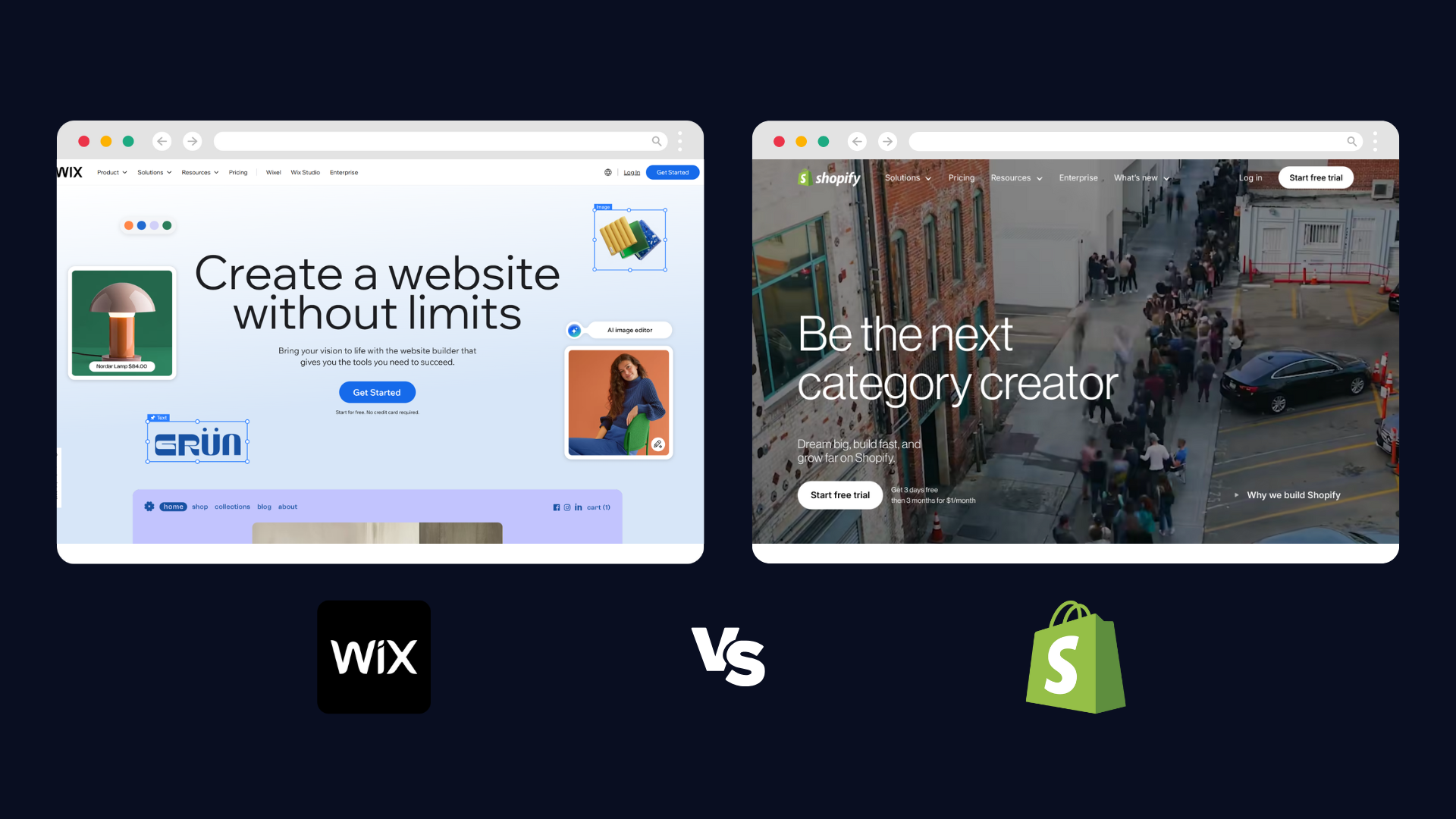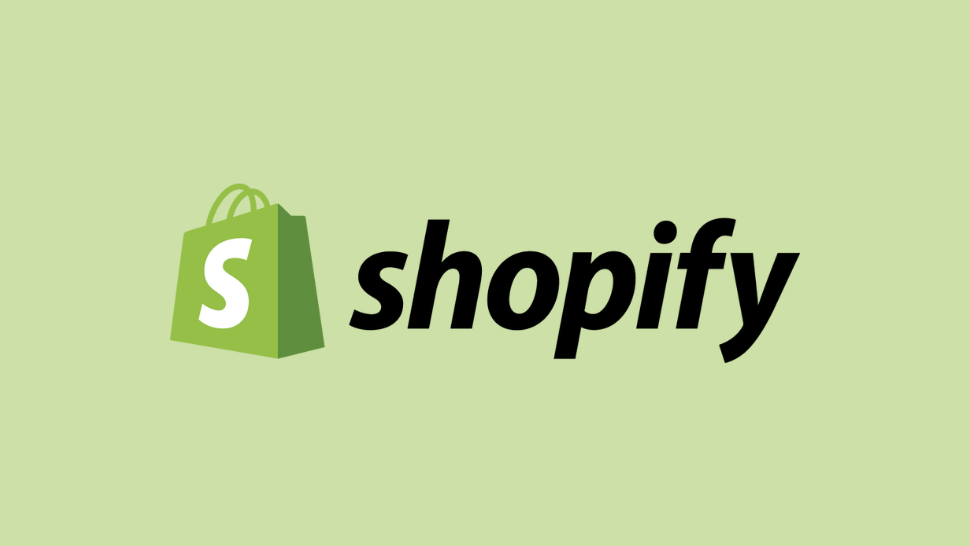Wix vs Shopify: Which website builder is better for ecommerce?
Your best pick for building an online store


Wix is designed for beginners and small businesses. You get an easy drag-and-drop editor, loads of templates, and built-in tools for selling online. We love how simple it feels, but power users will notice some limits.
Pros
- 2,000+ templates
- Mobile optimized storefront
- Multi-channel sales
- SEO tools included
- Easy drag-and-drop editing
Cons
- Limited advanced ecommerce
- Lower scalability
- Fewer payment options
- Not ideal for large stores
- Basic checkout features

Shopify is the go-to platform for serious sellers and big ambitions. It’s loaded with sales features, flexible payment gateways, and a marketplace packed with apps. Our tests show it’s powerful for scaling, though it’s more complex and pricey.
Pros
- 100+ payment options
- Advanced checkout features
- Scalable for large stores
- AI-powered customization
- Strong shipping tools
Cons
- Higher pricing
- Learning curve
- Extra costs for apps
- Limited free templates
- Complex for beginners
Wix and Shopify are two of the best website builder platforms for ecommerce in 2025. Both let you build an online store without needing to code. But there are clear differences in ecommerce power and flexibility.
Wix is best for small to medium businesses looking for an easy-to-use and affordable solution with basic commerce features. Shopify is geared toward larger stores that want advanced features and scalability. Finding the best ecommerce builder is all about matching features to your goals, so this guide will help you get down to the brass tacks of each platform before you make your decision.
Wix vs Shopify: A detailed breakdown
Feature | Wix | Shopify |
|---|---|---|
Starting price: USD/month | $17 to $159 | $29 and up |
Free plan: Yes/No | Yes | No |
Templates | 2000+ templates | 800+ professional themes |
Editor type | Drag-and-drop, flexible | Section-based drag-and-drop |
Mobile optimization | Built-in mobile editor | Fully responsive design |
Multi-channel sales | Facebook, Instagram, eBay | Wide multichannel support |
Payment options | 70+ payment gateways | 100+ payment gateways |
Checkout features | Basic checkout options | Advanced checkout system |
Scalability | Small to medium stores | Large and enterprise |
Shipping tools | Basic shipping | Advanced shipping options |
SEO tools | Included and strong | Good built-in SEO |
App integrations | Many native apps | Huge app marketplace |
Ease of use | User-friendly | Intermediate complexity |
Customer support | Good | Excellent |
Best for | Small to medium ecommerce | Medium to large ecommerce |
Wix vs Shopify: Features
When you compare ecommerce features, Shopify pulls out all the stops. It offers powerful product management, global inventory sync, built-in automation, and advanced analytics. There’s a marketplace packed with apps, plus top-tier payment and shipping integrations, even for wholesale and B2B. Plus, AI-driven design tools and smart storefronts make Shopify super flexible.
Wix, meanwhile, delivers reliably well for smaller sellers. You get 2,000+ templates, easy drag-and-drop editing, multichannel sales, subscriptions, and strong SEO tools. Wix supports digital goods, a robust media library, and custom checkout, but its advanced ecommerce options are more limited. Both platforms have mobile-optimized design and strong security.
Shopify wins for features if you need high-end ecommerce tools, especially for scaling businesses or selling internationally. Wix is better for boutiques or creative brands looking for a simple yet stylish storefront.
Wix vs Shopify: Ease of use
Wix is built for beginners. You can launch a store in minutes thanks to its user-friendly editor, simple setup assistant, and clear dashboard. There’s no coding, and everything can be personalized right from your browser. Wix relies heavily on visual editing and AI support, with labeled options and helpful prompts. Even so, its deep feature set sometimes clutters the interface, which may slow down editing or overwhelm absolute newcomers.
Shopify feels more complex up front. The signup process is longer and sometimes confusing, especially for first-timers. After that, though, daily usage is straightforward, inventory, orders, and shipping are simple to manage. Shopify’s drag-and-drop block editor and mobile responsiveness are top-tier once you’re over the initial learning bump. You also get instant access to automation and smart reporting tools.
Sign up to the TechRadar Pro newsletter to get all the top news, opinion, features and guidance your business needs to succeed!
For pure simplicity, Wix is the clear winner. For sellers who like more control or those who aren’t afraid of a short learning curve, Shopify takes the edge.
Wix vs Shopify: Support
Wix and Shopify both offer solid support.
Wix provides 24/7 live chat, email, and phone callbacks for all users (with priority for higher plans). Most issues are sorted quickly through live chat, and the help center is always available. Some advanced questions or phone support may have wait times depending on language and region, but response rates are excellent.
Shopify also has 24/7 support via live chat, email, and phone. A global help center packed with guides, forums, and FAQs backs up human agents. Shopify even integrates AI-powered chat and support apps for fast troubleshooting. Free trial users get access too, but there are extra perks for paid plans like specialist channels for technical and developer questions.
Shopify wins here for reliability, speed, and depth. Wix is great for everyday needs, but its support ecosystem is less robust for high-volume sellers and technical challenges.
Wix vs Shopify: Pricing and plans
Wix pricing is straightforward. There's a time-restricted free trial and a forever-free plan with limited features, which is great for test runs while you get your sea legs. Paid plans range from $17/month to $159/month, billed annually. Features scale up with price: higher tiers unlock advanced ecommerce tools, extra storage, and priority support. What we love is no hidden fees or renewal spikes, so budgeting is simple.
| Row 0 - Cell 0 | Free | Light | Core | Business | Business Elite |
Price (annual) | $0/month | $17/month | $29/month | $39/month | $159/month |
Price (monthly) | $0/month | $29/month | $39/month | $46/month | $172/month |
Collaborators | None | 2 | 5 | 10 | 15 |
Storage Space | 500MB | 2GB | 50GB | 100GB | Unlimited |
Custom Domain | Not included | Free 1st year | Free 1st year | Free 1st year | Free 1st year |
Ecommerce | None | None | Basic | Standard | Advanced |
Site Analytics | Basic | Basic | Basic | Standard | Advanced |
Marketing Suite | Basic | Basic | Basic | Standard | Advanced |
Dropshipping | None | None | 25 products | 250 products | Unlimited |
Customer Reviews | None | None | None | None | 3,000 reviews |
Sales Tax Automation | None | None | None | None | 500 transactions/month |
Recommended For | Testing | Personal | Small stores | Established | Large brands |
Shopify starts with a 3-day free trial, then offers a month at $1, and paid plans kick in after starting at $29/month. Advanced plans offer more staff accounts, inventory locations, and lower transaction fees. Shopify has a Starter tier (for basic online presence) and a Plus tier for enterprise sellers (with custom integrations and priority support). Pricing varies by region, but overall, Shopify is pricier, especially once you start adding paid apps or custom integrations.
Basic | Grow | Advanced | Plus | |
Price (annual) | $29/month | $79/month | $299/month | $2,300/month |
Price (monthly) | $39/month | $105/month | $399/month | Custom/Contact Sales |
Collaborators | 2 | 5 | 15 | Unlimited |
Storage Space | Unlimited | Unlimited | Unlimited | Unlimited |
Custom Domain | Included | Included | Included | Included |
Ecommerce | Essential | Growing | Advanced | Enterprise |
Site Analytics | Standard | Professional | Advanced | Advanced |
Marketing Suite | Standard | Professional | Advanced | Advanced |
Dropshipping | Yes | Yes | Yes | Yes |
Sales Tax Automation | None | Yes | Advanced | Advanced |
Transaction Fees | 2.9% + 30¢ | 2.7% + 30¢ | 2.5% + 30¢ | Custom |
Recommended For | Small stores | Startups | Large Stores | Enterprise |
Wix wins for small business budgets. Shopify is better for serious sellers who need more advanced tools and scalability, just expect a steeper monthly bill especially with transaction charges if you use third-party payment gateways.
Wix vs Shopify: Final verdict
Wix and Shopify are both excellent, but they serve different needs. Wix stands out for its simple setup and affordable prices. It’s perfect for personal brands, creatives, and small stores. Shopify is the powerhouse for bigger shops, advanced sales, and global ambitions. If you want to grow fast or sell thousands of products, Shopify’s tools can’t be beat.
Our advice: choose Wix for an easy start on a tight budget and pick Shopify if you need deep ecommerce features and room to scale.
Wix vs Shopify: FAQs
Which of these online store builders is easier to use?
Wix wins for ease of use. The editor is super intuitive, and you can drag and drop elements wherever you want. Setting up a store takes just minutes, with lots of prompts to guide you. Shopify is more complex at first, though it offers a streamlined dashboard after setup. If you’re new to ecommerce, Wix is the friendliest entry point.
Can I sell digital and physical goods with Wix or Shopify?
Yes, you can sell both on Wix and Shopify. Wix has dedicated options for digital products, so artists and creators can offer downloads with zero hassle. Shopify covers digital goods too, plus physical, subscriptions, and even services. Both support inventory tracking and easy purchase flows—so you’re covered either way.
Is there a huge difference in payment options between Wix and Shopify?
Shopify really delivers here with over 100 supported payment gateways (including international options). Wix supports over 70, which still covers most needs but falls short for global stores. If you want maximum flexibility in how customers pay, including crypto or foreign currencies, Shopify is a better bet.
Which website builder is better for design?
Wix has over 500 templates across dozens of categories. You can mix, match, and move elements wherever you like. Shopify offers just as many built-in themes, but they are more professionally designed and easier to customize. For pure creative freedom, Wix still comes out on top. Shopify’s designs have tighter guardrails, which can be good for keeping things consistent.
Are there any hidden fees with Wix or Shopify?
Wix offers a free plan for testing, with paid options from $17/month. There aren’t sneaky costs, and you get a lot included. Shopify’s plans start at $29/month, plus you may pay extra for apps and transaction fees. The bigger your store, the more you’ll likely spend on Shopify. For tight budgets and transparency, Wix is the winner. For serious sales, Shopify delivers better value for your money.

Ritoban Mukherjee is a tech and innovations journalist from West Bengal, India. These days, most of his work revolves around B2B software, such as AI website builders, VoIP platforms, and CRMs, among other things. He has also been published on Tom's Guide, Creative Bloq, IT Pro, Gizmodo, Quartz, and Mental Floss.
You must confirm your public display name before commenting
Please logout and then login again, you will then be prompted to enter your display name.